Before the Bicentennial: Muscogees from Tallahassee area forced into the 'unknown land'
When the Muscogees were forced to leave Florida’s Panhandle and walk to new lands in Indian Territory in Oklahoma, they sang:
“I am leaving my home, (with faces towards the South)I am going to the unknown land, (with faces towards West)Death is certain and sure,How far is my journey, I do not know.”
These words were sung by members of the Apalachicola Band of the tribe, according to the Indian-Pioneer Oral History Project.
The Indigenous people who lived in Tallahassee have gone by many names, depending on who wrote the treaty or took control of the land. Some of their descendants are known today as the Muscogee, the Creek and the Apalachicola Band from Tulwa Thakko.
White settlers pushed most of the Muscogees out west, and others who escaped to the south are today known as the Florida Seminole.
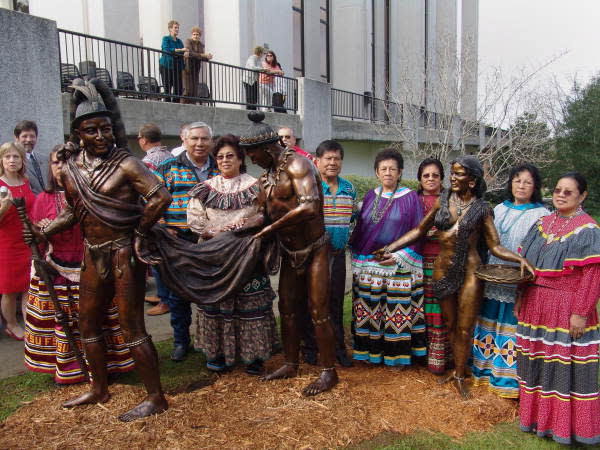
Planters drove Muscogees out of their home – their “Garden of Eden,” as one elder described it – to plant cotton on the fields that had been cultivated for centuries for corn and squash.
For 200 years, the Muscogee Nation has lived in Oklahoma. The federally recognized tribe is made up of the descendants of the Indigenous groups who lived in the South, including Tallahassee. Generations of Muscogee Nation members have been born in the colder climate of Oklahoma since 1824, when Tallahassee was established as the capital of the then-territory.
On March 4, Tallahassee will celebrate its bicentennial, with "Ambitious from the Beginning" as its theme. But a celebration of the creation of the city represents something far different to the descendants of the Indigenous people of Florida.
“It’s a zero-sum game,” said Turner Hunt, the tribal historic preservation officer for the Muscogee Nation of Oklahoma. “As Tallahassee grows, we lose.”
Tallahassee’s history is still on the minds of those in Oklahoma who consider the Southeastern U.S. as their ancestral home, even 200 years later.
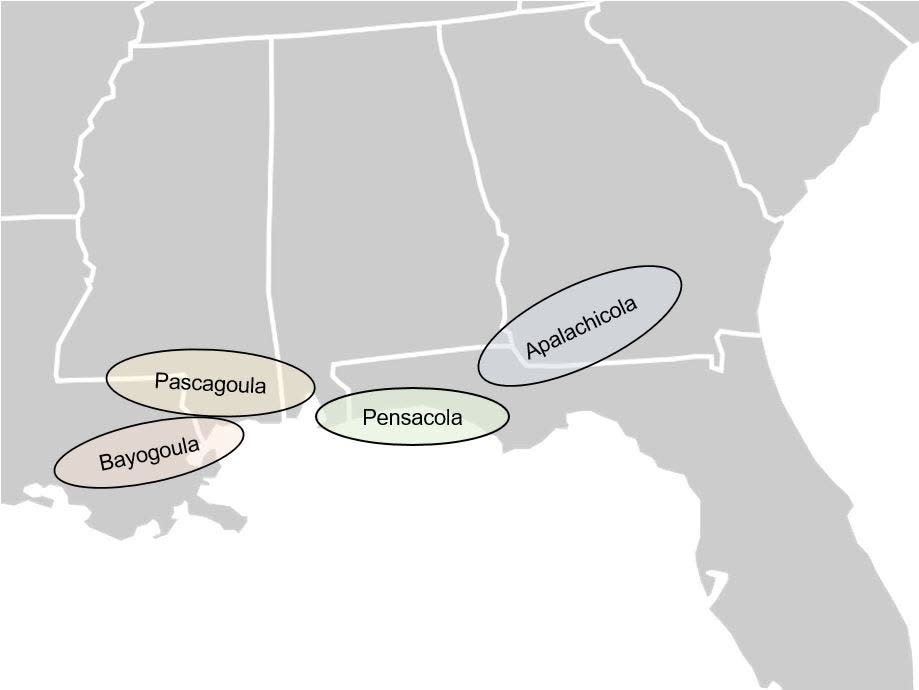
“Most people grow up knowing they’re from a culture that was removed from somewhere else,” Hunt said.
Current archaeological research shows Tallahassee has been a population center for 14,000 years, said Sam Wilford, the deputy state archaeologist for the State of Florida.
"We should celebrate the bicentennial in terms of historical context, but as a place, it's been a place a lot longer than that," Wilford said.
Celebrations for some, solemn reminders for others: 'The messiness of history'
Before the Spanish arrived in the 1500s, Tallahassee and the surrounding areas were inhabited by the Apalachees. It was a hierarchal community with farm lands on the exterior.
Tallahassee at the time was considered one of the major centers of life for the Apalachees, said Andrew Frank, a professor of Native American history at Florida State University. The council house at Mission San Luis is evidence of a large number of people living in close proximity to one another.
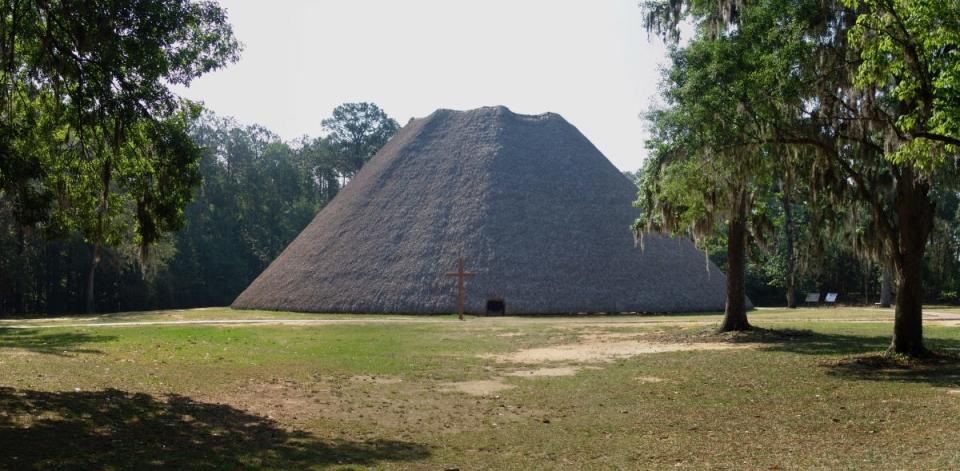
For about 200 years, the Apalachees were exploited by the Spanish and lived in missions or in small towns throughout the Panhandle.
When the English arrived, they partnered with other Indigenous groups and fractured communities, raiding and capturing thousands of Florida’s Indigenous people to sell them into slavery in the Caribbean and the colonies.
Those communities collapsed, but they didn’t disappear. Throughout the 1700s, the remaining people created new groups that formed connections with each other as they resisted colonialism. In this region of the South, some of the Indigenous became known as Creeks.

The history gets bloodier and lonelier for the remaining Indigenous people left in the Panhandle.
The War of 1812, the First Seminole War and the Treaty of Camp Moultrie, among other watershed events, splintered the already vulnerable Creek community, which spoke Muscogee and Hitchiti. While some were forced south to make way for cotton plantations, some of the remaining Muscogee became the Apalachicola Band.
In October of 1823, in a letter to territorial Gov. Richard Keith Call, John Lee Williams called the land in Tallahassee “first rate,” and wrote “every vegitable (sic) cultivated here is luxuriant.”
Williams wrote of where to start building, a “site shall be fixed near the old fields abandoned by the Indians after (Andrew) Jackson's invasion,” and added “the Indians I know do not intend to remove until they shall be obliged; when they do, most of them, instead of going south, will return to the upper Creeks.”

History: An hour north of Tallahassee, Native American Creeks preserve, teach their heritage
But the old fields of corn and squash weren’t “abandoned” after the First Seminole War, said Frank.
“By 1820, many Indians were returning to and rebuilding their homes in the Panhandle only to have the option taken from them,” Frank said.
After Tallahassee was established, the U.S. continued to push members of the Muscogee Apalachicola Band to move west, and by 1840, most of the Muscogee-speaking Creeks were removed from the region.
An account by Muscogee-Creek Chief Opothle Yahola describes one of the last groups of people to move to Oklahoma, who arrived “In a deplorable situation; a good many of them are naked and have no means by which they can obtain subsistence.”
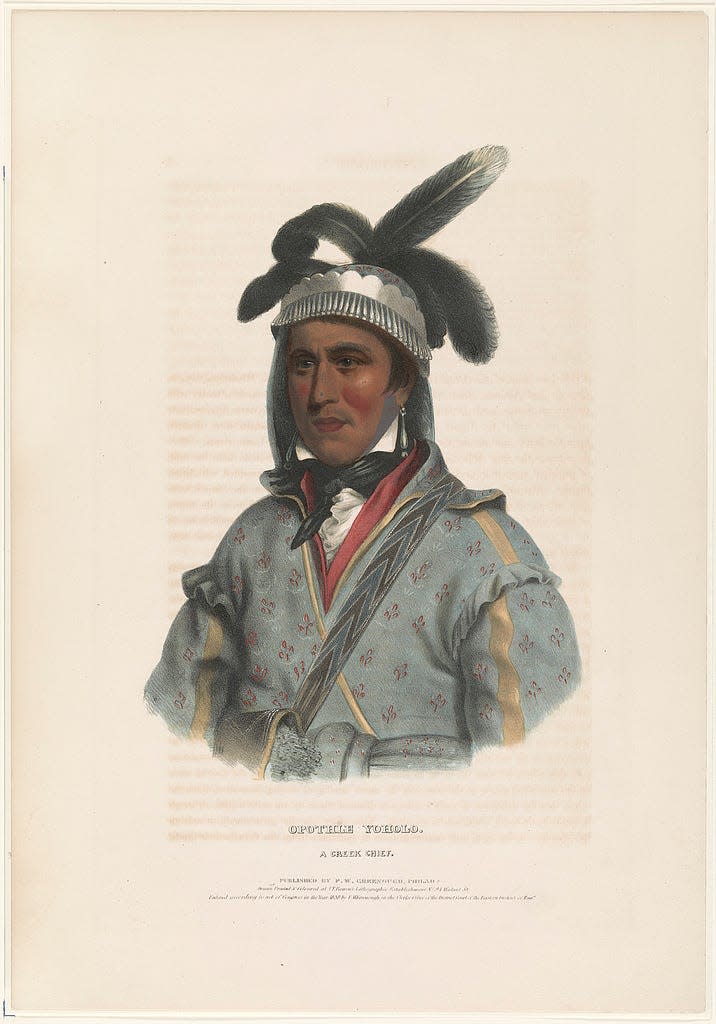
Frank, who has researched Native American history for almost 30 years and has taught at FSU since 2007, said historians have uncomfortable relationships with anniversaries for this reason.
“They tend to become celebrations, not moments of commemoration,” Frank said. “For lots of people, the creation of Tallahassee was not a good thing. This allowed for the expansion of slavery, it meant the removal and sometimes the eradication of Indian communities. This is not a moment of uplift, for other people it was."
"That's the messiness of history.”
Indianhead, Apalachee Parkway and local 'signs of Americanness'
When the Creek left Florida, they brought their names with them. There’s a Tullahassee, Oklahoma, almost 900 miles away.
In Tallahassee, Florida, Indigenous words can be seen throughout the city. The area’s landmarks, like rivers and streets, are labeled with sometimes anglicized terms for Indigenous words used for centuries.
There's Apalachee Parkway, a street named through a contest in the Tallahassee Democrat, that ends at Florida's Capitol. Chattahoochee is derived from Muscogee words that mean “painted rock.” Miccosukee Road, also spelled Mikasuki, is a Hitchiti word to describe a group of people who now live as Seminoles and Miccosukees in South Florida.
And Tallahassee means “old town,” a designation given to this area by the Apalachees, who spoke a Muscogean language: “talla” means town, and “hassee” means old.
The juxtaposition of old and new, before 1824 and after, gets muddled in the mid-20th century.
In the late 1940s and 1950s, the United States went through a trend of naming things after Indigenous people as a way to honor Native American history. In the U.S. post World War II, westerns were one of the most popular genres at the movie theater and made up one-quarter of all the films made in the U.S.
“Lots of places start using Native American motifs or names as a sign of Americanness,” Frank said.
In Tallahassee, FSU chose the Seminole as the school’s mascot in 1947. That same year, developers John and Irene Stead purchased 480 acres of property formerly known as Indianhead Plantation – for a now-unbelievable $65,000, wrote Tallahassee Democrat writer Gerald Ensley.
Irene Stead worked with W.T. Cash, the first state librarian, to develop street names for what is now the Indianhead Acres neighborhood. Today, the neighborhood’s website touts the names of its streets, calling them “authentic Seminole names.”
But like sports team mascots, which can turn Native Americans into “caricatures,” the FSU professor Frank said, white Americans actually accomplished the opposite of their intent to “respect” Native American history and left them out of the conversation.
Eli Rowland-Chang, the language revitalization project manager for the Muscogee Nation in Oklahoma, sees shades of that in Indianhead. She said there is no Seminole language, and after reviewing Indianhead Acres’ street names she said that the words for First through Ninth Streets are wrong and backward.
“It gave me a good laugh, actually,” she said.
For Second Street, just like in English, the word "two" and the word "second" aren't the same thing in Muscogee. Also, numbers are placed after nouns.
"We say 'street second.' Right now, all these roads look like they are saying 'two roads, three roads, four roads' with bad grammar," she said.
While the majority of Indianhead Acres’ street names are innocuous, one street name did concern Rowland-Chang. Ohbah Nene, “owl street,” is named after an animal that many tribes consider a bad omen.
For example, in the TV show “Reservation Dogs,” the eyes of the owls in the show are blurred out.
“This felt like a rather disrespectful choice to choose 'owl’ over any of the other amazing creatures found naturally in those areas,” she said.
Nic Zateslo, 37, grew up in Indianhead Acres and now lives on Atapha Nene, down the street from his parents. Growing up, the story he heard was that the street names were chosen by the developer's wife, who was fond of Native American culture.
“It wouldn’t surprise me it wasn’t a well-thought research project,” Zateslo said. “I think it’s very interesting to know the real and true history of things."
'We still exist': How Muscogees are represented in Tallahassee bicentennial
Tallahassee isn’t unique in how it has reckoned with its Indigenous history. While local leaders have memorialized the city’s Native Americans through high school mascots, street names and statues, the people of the Muscogee Nation of Oklahoma, or any Native tribe, have often not been included in preserving their culture in the U.S. until recently.
It wasn’t until 1990 that federal law provided for the protection and return of Native American human remains and sacred artifacts.
From Oklahoma, Hunt and his staff constantly monitor construction projects in their “homelands,” he said.
“We try to look at it to make sure that things aren't happening to our ancestors,” he said.
Hurricane Michael uncovered many culturally significant sites, including human remains, in the Florida Panhandle. The best case scenario when state archaeologists identify human remains is to work with the descendant communities to return them to their original location and rebury them.
It’s a process that can take time, Hunt said.
Back in Tallahassee, the state archaeologist Wilford said artifacts are being unearthed in Florida almost on a weekly basis as the state experiences a boom in development. When the remains of Indigenous people are found, "9.5 times out of 10" they can be reburied.
In Tallahassee, there are mounds yet to be discovered in neighborhoods, communities built on top of homes that people lived in hundreds of years ago.

"There's history underneath your feet, I mean everywhere," Wilford said.
Sometimes when artifacts are uncovered, it spurs a reconciliation, like in Oxford, Alabama. After artifacts and remains were uncovered during a development of a local park, the city of Oxford and the Muscogee Nation started a partnership, which resulted in information about the area’s Native American history and a reconstructed ceremonial mound on the park’s site.
Ten years later, Oxford threw a homecoming celebration for the Muscogee Nation in 2021.
And last year in Macon, Georgia, the Muscogee Nation’s flag flew at Macon’s City Hall. The Macon-Bibb County Commission passed a resolution that recognized “the sustained oppression, land dispossession, and involuntary removals of the Muscogee (Creek) peoples from, Macon, from Georgia and from the Southeast,” the resolution reads.
“The Government of Macon-Bibb County seeks to honor the Muscogee (Creek) Nation and other Indigenous caretakers of this land by humbly seeking knowledge of their histories and committing to respectful stewardship of the land.”
Hunt is currently working on a side project that reconstructs what ceremonial mounds look like. In Tallahassee, the Lake Jackson Mounds are now covered with clover, grass and trees, with wooden stairs that ascend on one side. But years ago, those steep sides of green were once bright walls made of red and white clay, Hunt said.
It’s been 200 years since Tallahassee was chosen to be the capital city of Florida. Since then, well-meaning assumptions and lore have sometimes replaced the real Native American history of the Apalachicola Band from Tulwa Thakko, some of the last Indigenous people to have lived here.
Hunt said he wishes more people learned about Native American history. It would make life easier.
“Having to start at square one every single time, like explaining to somebody ‘hey, you know, we still exist and we used to live there,’ it would be helpful if that was already understood,” he said.
“We can't go back and change the past,” he added. “The only thing that we can do is build on it from here.”
And that's what some on the city and county's bicentennial committees are trying to do.
Friday, the Old Capitol opens an exhibit, "Becoming Florida's Capital," showcasing the Indigenous history of the region. Historians partnered with the Seminole Tribe and the Miccosukee Tribe of Florida to bring artifacts for the public to learn about the history of Tallahassee before 1824.
On Thursday night, there was a reception at the Historic Capitol for sponsors, partnering organizations, lenders and artists that included representatives from tribes descended from those who used to live in Tallahassee.
A sculpture will also be installed in Cascades Park with an inscription that alludes to Tallahassee's history even before the 1500s.
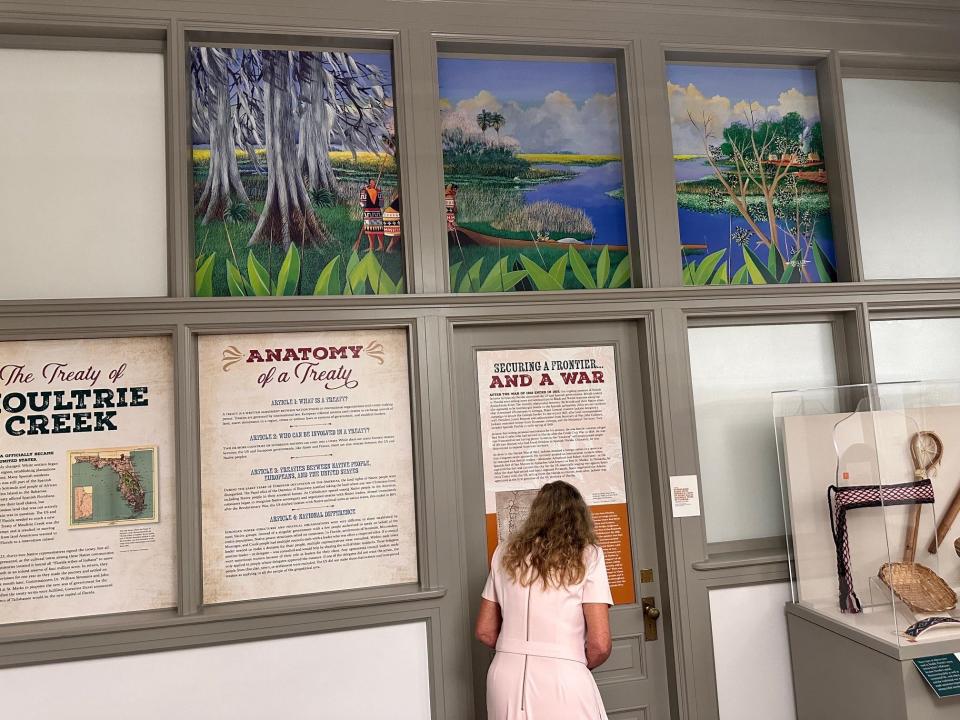
"For thousands of years, the land drew people in because of its natural resources and beauty," said Elizabeth Emmanuel, director of the Downtown Improvement Authority and a member of the Bicentennial Steering Committee.
"It's an exciting opportunity for everyone in our community to get to learn more, because its timeline is the most significant in the state's history," Emmanuel said. "As a whole, I worry we don't acknowledge our history enough as a community, and I hope the bicentennial offers opportunities for the community to educate themselves."
'Becoming Florida’s Capital' Exhibit:
The Florida Historic Capitol Museum invites the public to meet Tallahassee's Indigenous residents and explore the historical actions and power struggles that defined early Tallahassee and led to the city 'Becoming Florida’s Capital.' On display from Friday through January 5, 2025.
Museum hours: Monday - Friday: 9 a.m-4:30 p.m.; Saturdays: 10 a.m.-4:30 p.m.; Sundays and Holidays: Noon-4:30 p.m.
This story is part of TLH 200: the Gerald Ensley Bicentennial Memorial Project. Throughout our city's 200th birthday, we'll be drawing on the Tallahassee Democrat columnist and historian's research as we re-examine Tallahassee history. Read more at tallahassee.com/tlh200. Ana Go?i-Lessan can be reached at [email protected].
This article originally appeared on Tallahassee Democrat: Tallahassee bicentennial a more solemn occasion for Muscogee tribe
